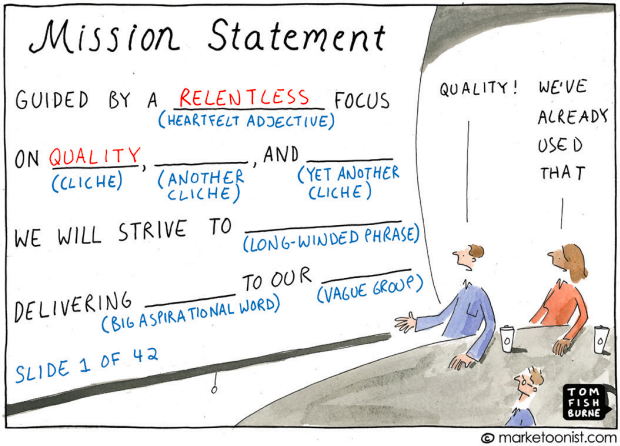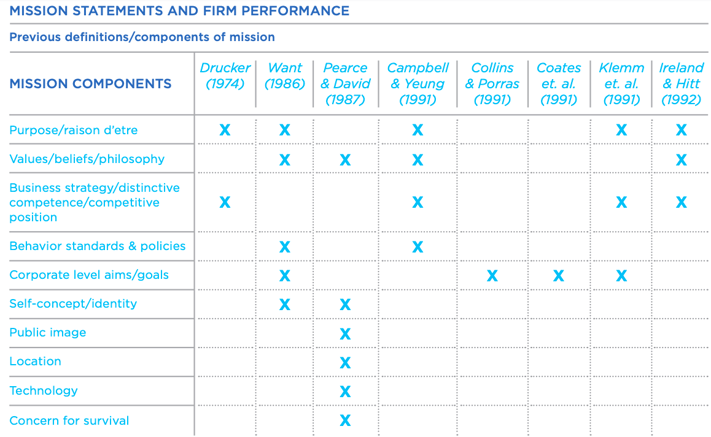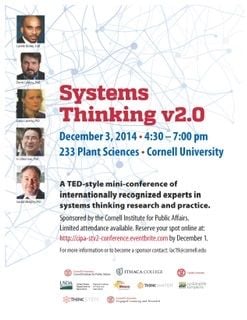Mission Confusion Abounds!
 Derek & Laura Cabrera
·
3 minute read
Derek & Laura Cabrera
·
3 minute read
This blog is an excerpt from Chapter 3 of Flock Not Clock.
Starting in the 1980s, there was tremendous pressure to create a mission statement (some blame Drucker, who was so right about so many things, for encouraging them). The job of creating these statements was often relegated to a small group of individuals or outsourced to consultants. Neither process was particularly conducive to innovation, originality, or realism. There was pressure to create something, but no one was really clear about why it should be created. The process was self-conscious, in that leaders probably were concerned more with “how it reads” than “what it means,” let alone “why am I doing this?” Not to mention that there has never really been clarity or agreement about what a mission statement is, what it should do, and what belongs in it.
When it comes to mission statements, the experts disagree about fundamental things like purpose, audience, and content. Here’s a good example (just one of several dozen) of mission-making instructions that radically miss the mark. A business consultant, CEO, and author wrote a piece in the Huffington Post titled “Is Your Business Confused?” explaining the importance of writing a mission statement for your company.
The author offers “a few essentials” for any mission statement.
• The purpose and aim of your organization (i.e., a definition
of what your company is and does)
• The products and/or services your company offers
• What your company aspires to be
• What features/characteristics distinguish your company
from its competitors
• Your company’s core ideology, values, purpose, and
visionary goals
Other prescriptions are vague in a way that leaves the reader unclear about what they should write. Jeffrey Abrahams, author of The Mission Statement Book, describes a mission statement as “a declaration of the company's purpose...the mission statement brands the business and hopefully differentiates it from the competition so that customers understand that the company is committed to a purpose and will back that up with products and service.”
 Figure 3.2: All too real...
Figure 3.2: All too real...
This is in contrast to the Army's version of a Mission, which communicates the “5W’s:”
Who: the people involved, across the scale from organization
to division to department to team;
What: the unit's essential task and type of operation;
When: the time given in the battalion operation order;
Where: the location stated in the mission; and
Why: the company purpose, taken from the leader’s concept
of the operation.
These elements guide the "actions" that comprise the stated mission. Military operations are executed through a mission order to accomplish a mission - which at times sounds more like a corporate vision (e. g.,"take that territory”). Generally speaking, successful missions are the result of clear articulation and execution of all elements of the mission as stated by the commander. “Under mission command, commanders provide subordinates with a mission, their commander's intent, a concept of the operations, and resources adequate to accomplish the mission. They leave the details of execution to their subordinates and expect them to use initiative and judgment to accomplish the mission.”
While the U.S. military has a clearly communicated understanding of a mission, the study of corporate missions is plagued by a lack of consensus on and clarity about key terms and the object of analysis itself. For example, one study described 23 years of research that used definitions of mission statements composed of widely varying items (as many as 10 items in one definition). As is the case in many fields where our knowledge is nascent, inconsistency in defining the object of study hinders progress. The authors write, “there appears to be virtually no consensus as to what mission statements should or should not include.” Table 3.1 shows the authors’ summary of the “content” of mission
from key works on the subject.
 Table 3.1: Components of different mission definitions
Table 3.1: Components of different mission definitions
Yet there is hope! Not every business consultant or company or expert is confused on the subject of mission. Many folks are, at least in many respects, getting it right. Leanne Hoagland-Smith, a consultant in the area of organizational culture, makes a valuable etymological point.
A vision in its earliest definition means to see and has been translated into the act or power of seeing...
Now mission is entirely different. From its Latin origins it means to send, not see. Mission therefore implies action. For action to have value it must be measurable
and directly connected to the power of seeing. Without the measurement, the old expression rings true, if you cannot measure it, you cannot manage it.
.png?width=150&height=150&name=CRL%20GOAT%20Logo%20(4).png)



